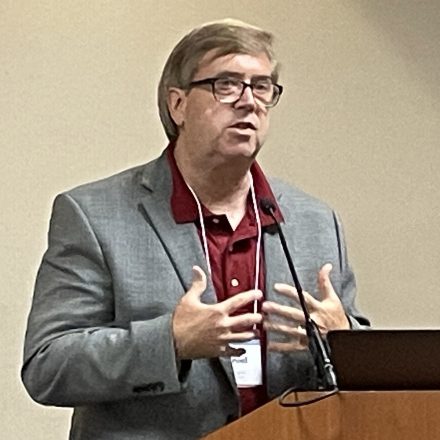The School of Communications faculty members attended the 2023 American Journalism Historians Association (AJHA) conference held in late September in Columbus, Ohio.
Daniel M. Haygood, professor of strategic communications, and Lorraine Ahearn, assistant professor in journalism, were among the presenters at the annual American Journalism Historians Association (AJHA) conference held in Columbus, Ohio. The three-day event, held Sept. 28-30, brought together media history scholars from around the nation for presentations, panels and discussions.

Founded in 1981, AJHA aims to “advance teaching and research in mass communication.” The annual conference provides scholars with an opportunity to share their research and ideas with other media history researchers.
Haygood presented on two topics related to his research in media history. His primary presentation, “The Final Say on the Last Japanese World War II Holdout: The Asahi Shimbun’s ‘Ki no Hito’ Article Series on Hiroo Onoda,” analyzed a series of articles about the famous Japanese intelligence officer who continued fighting on the Philippines’ Lubang Island 29 years following the official end of the Pacific War in September 1945. Onoda’s three decades on the island have been hailed as reinforcing the traditional values of the Japanese and the “bushido” or samurai spirit, and those decades have been castigated for the harm inflicted on the local Filipino population.
Started in May 2011, the “Ki no Hito” articles highlight different individuals from the Kii Peninsula of Wakayama, located south of Osaka, over several years. “Ki no hito” can also mean “a person of history.” These short articles focus on unique individuals and their talents or vocations. Onoda was featured in 45 separate articles, telling the story of his of exploits and survival on Lubang Island.
Haygood’s research demonstrated that the Asahi paper captured stories, anecdotes and insights about Onoda, his life, and perspective that had not been covered previously in the extensive coverage Onoda received since returning to Japan in 1974. The research also confirmed the Asahi paper’s reputation as an investigative and somewhat iconoclastic organization in the Japanese journalism market.

Onoda passed away in 2014 at age 91 while the “Ki no Hito” articles were still running in the Asahi Shimbun.
During AJHA’s Research-in-Progress session, Haygood also presented his research work on the Atlantic Refining Company’s leadership role in sponsoring early sports radio and television broadcasting. In the earliest days of sports broadcasting, Atlantic Refining and its agency, N. W. Ayer & Son, were both innovators in sports broadcasting and sponsorship of professional and college sports. Both were leadership brands in anticipating America’s seemingly endless appetite for sports content.
Haygood expressed his gratitude for Elon’s Faculty Research & Development Committee, which providing funds to translate the articles. “My Japanese reading ability is adequate, but I could not have translated all the ‘Ki no Hito’ articles myself,” Haygood said.
He also thanked Duke University’s Bostock Library for its assistance during his research process. “Their help was key. They allowed me to use their Japanese newspaper database, Yomidas Rekishikan, to access the old Asahi Shimbun newspapers,” Haygood said.
As part of her presentation, Ahearn shared her new study, “Old-Time Negroes: Nostalgic Ex-Slave Narratives in New York Newspapers of the Gilded Age.” According to Ahearn, her research examines a conspicuous genre of front-page stories in mainstream white newspapers seeking to soften northern memory of slavery a generation after the Civil War. This trend appeared during a period of North-South reconciliation, helping set the stage for Jim Crow and what Henry Louis Gates Jr. has termed a “restoration of the social roles and psychological demeanor of the Old Negro.”
Ahearn, a media historian, demonstrated that staff-written stories in white newspapers across that partisan spectrum, from The New York Times and New York World to The Sun, New York Tribune, and Brooklyn Eagle, portrayed aging African Americans as nostalgic for the antebellum South and loyal to former slaveholders, accounts that consistently cast slavery as a benign system. This drew a running counterpoint from Black journalists and intellectuals writing in the pages of The New York Age, the study details. Ahearn argued that white newspapers, by upstreaming fictional tropes from plantation literature and minstrelsy to journalistic accounts of real people, became a key conduit in shaping white collective memory, just as new mass media forms of radio and cinema were to emerge. New York City had by far the highest concentration of daily newspapers, Ahearn noted, and by the 1890s, hundreds of thousands of Black Americans had migrated there from the South.
The study is part of a widening inquiry into the Jim Crow North, which scholars regard as a missing link in the history of race in America. Ahearn addresses a parallel gap in journalism history, which has principally focused on the role that white journalists in the South played in perpetuating white supremacy and revising memory of slavery.
“The ‘so-what?’ question of this study is easy to answer,” Ahearn said. “In changes to how we teach the history of slavery to school children, for example in Florida, and in presidential candidate debates, these ideas are still an issue in 2023.”


